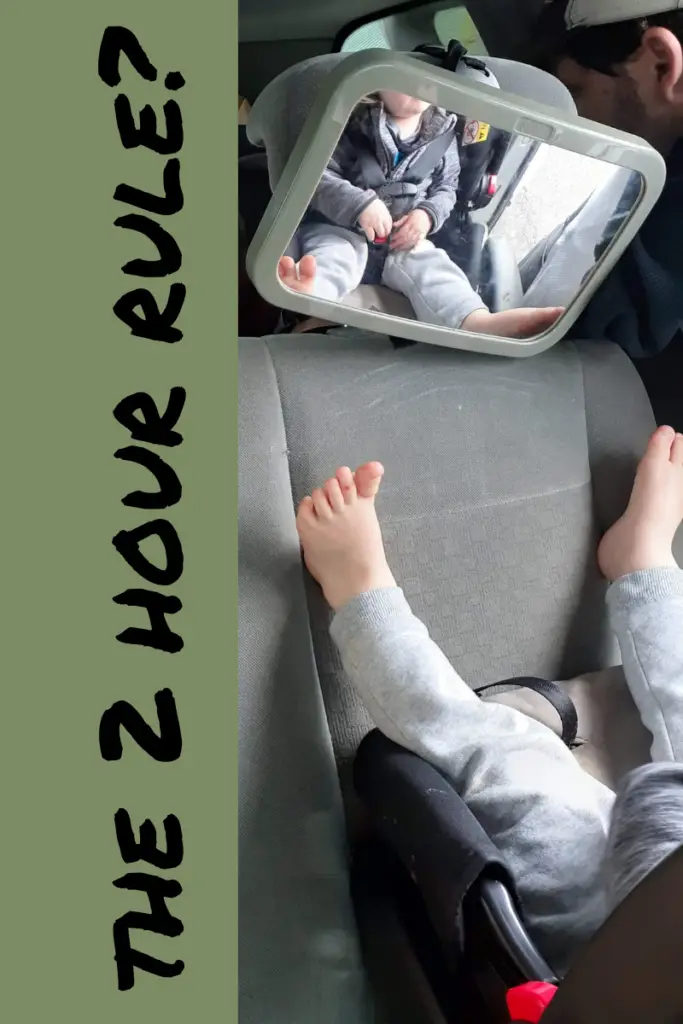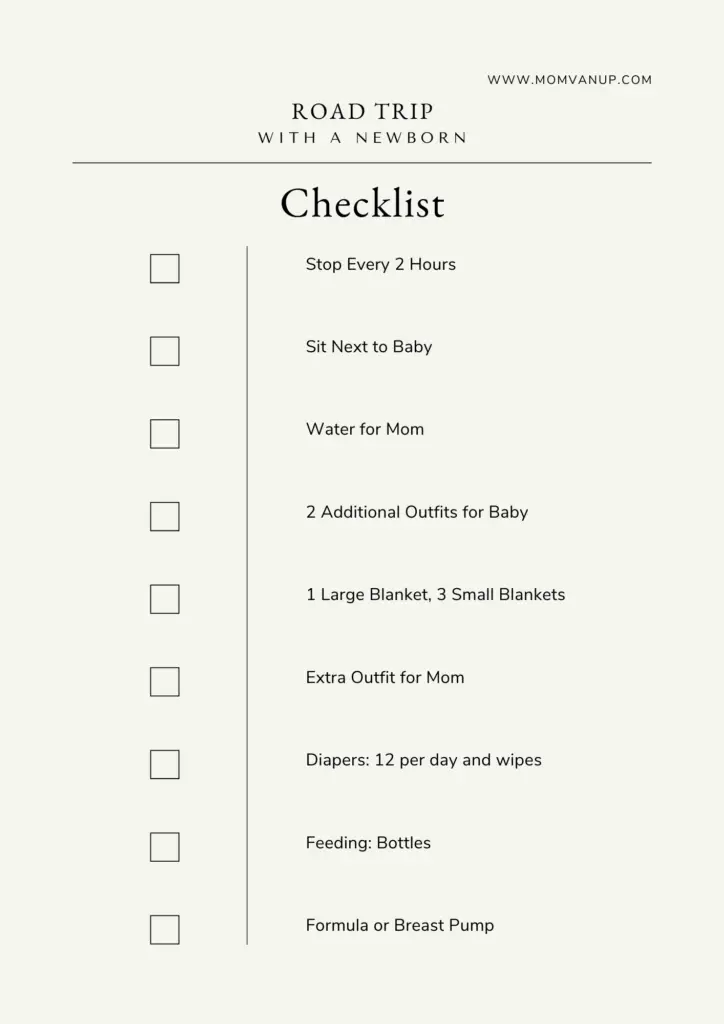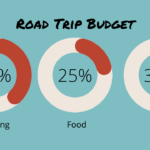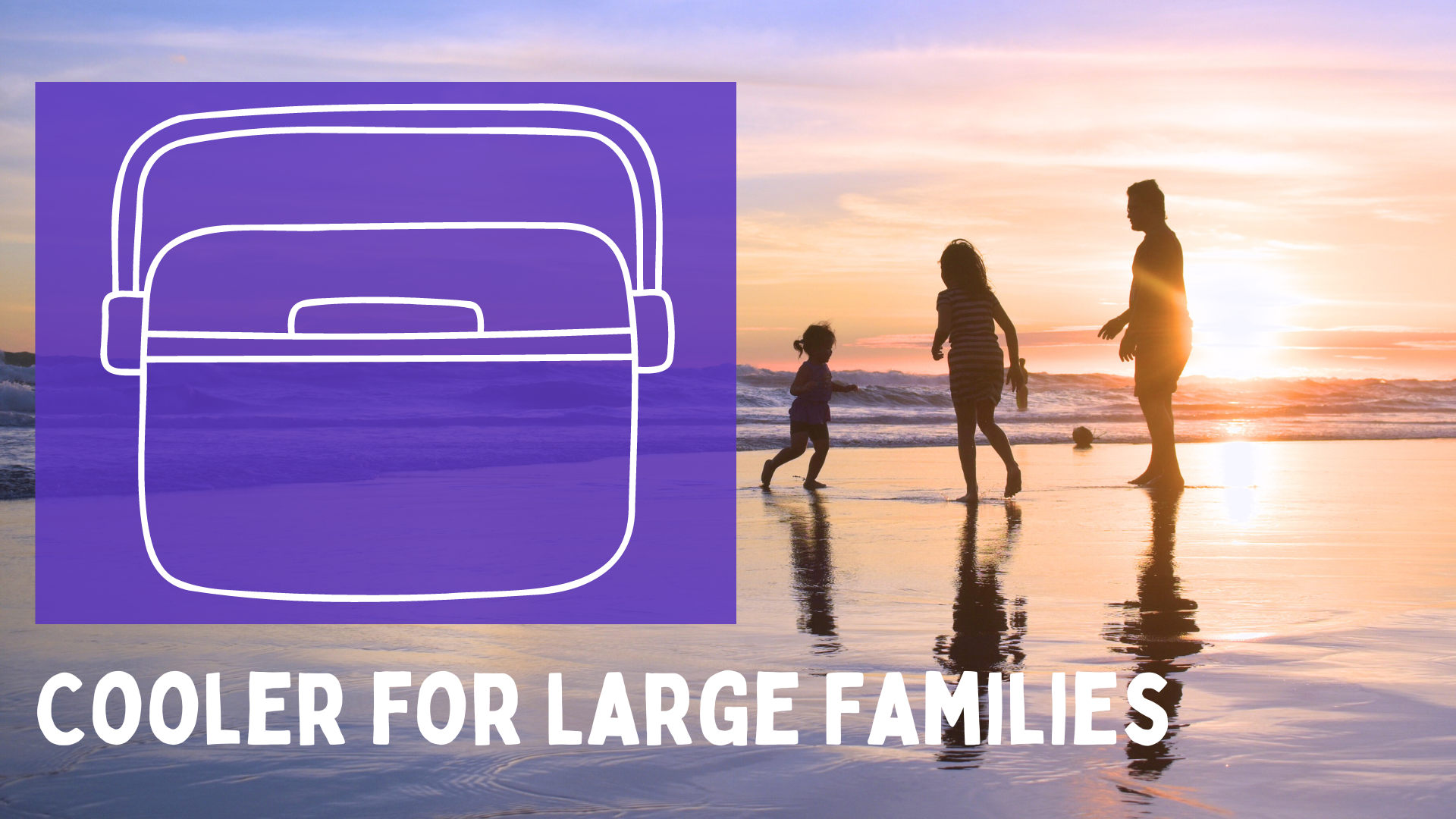Road trips are a great way for a family to travel because you can have more control over what to bring and when to stop and if you are traveling with a very small family member, plan to stop very often.
When planning a road trip with a newborn, plan to stop and take the baby out of the car seat every 2 hours and make sure that a caregiver is seated next to the baby to monitor their breathing and comfort. Be sure to pack enough diapers and have a convenient way to feed the baby.
Road trips are a great way to travel with your new baby if you have plenty of time and you plan ahead. I made this printable checklist to help you make the trip smooth.
When you are planning your trip look for some interesting stops along your route. You can use this Google Maps hack that helps me find really interesting things that are on our route, or you could use a paid service like RoadTrippers that has a lot of features to help you plan the whole trip and add interesting stops. Use my referral link and the code BTR5QTP for a $5 discount.
The most important thing to consider is car seat time.
The general rule is that babies should be taken out of their car seats every 2 hours, but the rule is every 30 minutes for babies under 4 weeks.
This rule is given by car seat manufacturers, not a medical organization, so I think it is more important to ask your pediatrician and to observe your baby to determine when they may need a break.
The concern is about positional asphyxia, when someone’s body position makes it hard to breathe. This is a problem for babies because they cannot easily change their own position.
The semi reclined position of a car seat makes positional asphyxia a real danger to babies.
Be sure to monitor your baby’s breathing whenever they are in their carseat.
Very young babies also need to eat pretty frequently. It can be safe to feed your baby while they are in the car seat, but they must be monitored closely. You should never use a bottle positioner or prop up the bottle for a baby. Hold the bottle and monitor the baby’s breathing and eating.
Feeding a baby is a HUGE topic and if you are wondering how often or how much your baby should be eating, you’ll have to chat with the pediatrician because it can vary widely between babies.
If you are breastfeeding and want to be able to feed your baby while the car is moving, pump and put the milk in a bottle.
I love using a manual breast pump, this is my favorite one, this is an amazon affiliate link, so if you choose to purchase I will earn a small commission at no cost to you.
The manual breast pump can be used to pump when you are rolling down the road. I always keep this with me on a long trip because on my first trip with my baby I leaked all over my outfit and had to go buy another one! Your milk supply is still regulating itself when your baby is very young, so leaks are common. Having the pump allowed me to save that milk and feed it to the baby.
Milk collecting devices like Haaka, Milk Savers and others can also be useful.
When Is It Safe To Travel With a Newborn By Car?
When traveling with a very young baby start by talking to your pediatrician. Most babies can sit in a car seat for 2 hours at a time safely, but some babies who have been born prematurely or have certain conditions may need to wait between 3-6 months before spending extra time in the car seat.
Very young babies are at the greatest risk of positional asphyxia from sitting in the car seat for a long time. When you are traveling with a baby less than 1 year old, always have an adult seated next to the baby on a long trip so they can monitor the baby’s breathing.
When traveling by car, you are in an extension of your home, so unless you are stopping at events or riding with someone outside of your household you are not introducing new germs.
On the other hand, mom needs to have enough time to recover after birth.
As the mom of 4 young kids, I would never take a road trip in the first 2-3 weeks after giving birth. It is really recommended that you spend this time bonding and recovering.
If you are traveling to family who will support your recovery, it may be worth the drive, but please monitor the baby carefully and stop at least every 2 hours, and travel with another adult. Be kind to yourself mama.
How long can a 1 month old travel in a car seat?
The most conservative rules recommend that babies spend no more than 2 hours in their car seats in a 24 hour period. Babies under 4 weeks old may need to be taken out of their car seats every 30 minutes.
These guidelines are a mixture of advice from well known medical organizations like the American Academy of Pediatrics and car seat manufactures. The gestational age of your baby, the weight and general health of your baby will also determine if your baby can safely travel in a car seat for longer than those recommendations.
When planning a long drive, discuss these concerns with your pediatrician who knows your baby and your family situation. They can give you the best advice.
I have done quite a bit of research and written quite a few articles about how long a road trip should be.
When traveling with a very young baby, I recommend that you follow the 2/2/2 rule. Drive no more than 200 miles, arrive before 2pm and stay for at least 2 nights. You can read more about the 2/2/2 rule for stress free travel in the linked post.
Can I bring my 1 month old on a road trip in an RV?
When road tripping in an RV it is important to follow all the same child restraint safety procedures as you would in the car. Be sure that your RV has lap and shoulder belts on a forward facing bench seat. It is not safe for babies or children to be bucked into sideways or backwards facing seats.
When traveling with babies and young kids it is recommended that they are allowed to get out of their car seats about every two hours, so use those times to change diapers and feed your baby. The great thing about traveling in an RV is you can do this in a parking lot without having to get out of the car.
It is tempting to take your baby out of the carseat when the car is moving to nurse, feed or change the baby when the car is moving, but it is much safer to stop and take care of these things.
We have a school bus conversion RV and the best thing about traveling this way is that you do not have to go into random rest stops with your kids.
Read more about RV road trip safety in this post from the American Academy of Pediatrics.

What should I pack for a road trip with a baby?
Oh, I love packing. I love having a packing list, I am a packing nerd.
When I am getting ready to leave the house I have a simple checklist that states by the door.

I also have a checklist that stays with the baby bag so that I can be sure I have everything when I leave the house.
I made this checklist for you! It is specifically for road tripping with a very young baby.
Be sure you cover all the bases: Feeding, Diapering, and Clothing
Feeding
Water and formula for formula fed babies, be sure to overpack here in case you end up being out longer than expected.
Breastfeeding mamas, be sure you have a nursing cover if you prefer one, a big blanket is very versatile here. I also almost always carry my manual pump in the early days, I just throw it in a ziploc in the baby bag. It is just so convenient and affordable.. This is my favorite baby shower gift.
Bottles. Even if you do not usually use bottles, keeping one clean bottle is a great emergency item to carry with you.
Diapering
Put a basket with a stash of diapers, wipes and rash cream under a seat close to the door, that way if you just have to run in to change a diaper you do not have to grab the whole baby bag.
Pack a rash cream that you have used before, road trips and long times in car seats can cause more frequent diaper rashes, so be sure to change often and use barrier creams generously.
The best way to plan for diapers is to keep track of how many you usually use in a day and pack 2-3 extras per day of your trip. Find more information on diapers for road trips in this post that has a more elegant formula.
Cloth diaper mamas, be sure to have enough diapers to get you to laundry day. I also like to carry 1-2 extra wet bags so that one is always within reach. I like flats and covers for the flexibility for sink washing if necessary, but a large stash of pockets would also be very convenient.
I like to keep a few flour sack towels in the car, they make great extra diapers if you find yourself needing some extra. They are also great for wiping up spills, and as a blanket.
There is no shame in using disposable diapers for your vacation, I have loved cloth diapering, but disposable diapers have their merits at times as well.
Clothing
Make sure to have at least 2 extra outfits for your baby. I recommend that you bring an extra outfit for yourself as well.
I just so vividly remember how wet everything always was when I had a new baby. Spit up, leaking diapers and milk are everywhere.
If you are breastfeeding, your supply is still regulating and your baby will likely sleep more than normal because of the calming noises and movements of the car. An extra change of clothes for mom will come in handy if you leak all over your entire outfit in a Chipotle parking lot, ask me how I know.
Grab the printable checklist for some more packing inspiration.
I keep three small bags inside my diaper bag. This helps me stay organized and lets me know quickly what I need to restock.
- Clothes
- Diapers
- Snacks (for my older kids)

Here is a video of my baby bag set up.
How often should you stop on a road trip with a baby?
Stop every two hours when you are on a long trip with a baby. You may have to stop more often if you have a very young baby. Be sure that you are monitoring your baby to be sure they are breathing well and comfortable.
It is recommended that you change your baby’s diaper every two hours and it is recommended that they get a break from the car seat every two hours, so that makes it a pretty easy decision.
I have a method for planning out the legs of a road trip that will help you find places to stop that are two hours apart along your route.
As long as your pediatrician (who know’s your baby’s health much better than me) gives you the green light for a long road trip, go for it.
Road trips are a great family vacation.
Bonus Tip
The American Academy of Pediatrics recommends that you pack a small medical kit in case of a minor emergency.
They recommend in this white paper that you include:
- acetaminophen or ibuprofen
- Sunscreen with 100% UV protection
- Band-aids and gause and tape
- Anti-allergy medicine appropriate for your baby
- tweezers, small scissors
- prescription medication for your child
- pediatrician’s phone number
Our family has this first aid kit from Amazon that we really love and have used a lot. We ended up using the burn cream first and we were very grateful to have it. The link is an Amazon affiliate link and I earn a small commission at no cost to you if you choose to purchase through my link.




